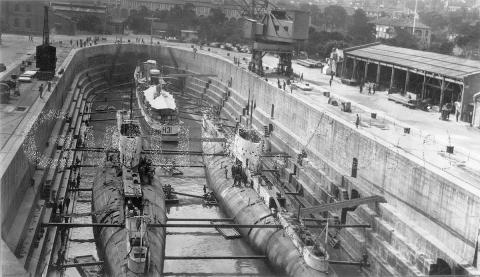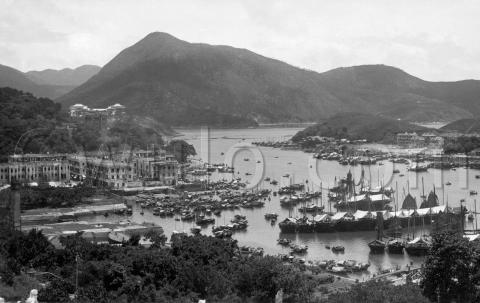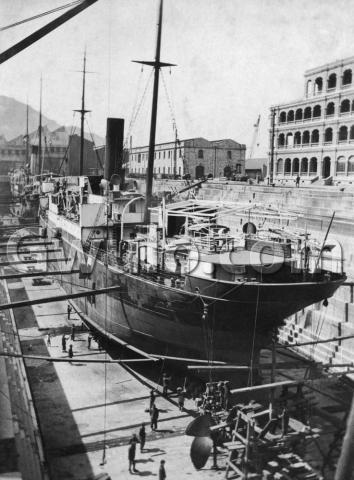For my new talk, we'll look through the eyes of different people connected with Hong Kong's harbour. As you'd expect, the Royal Navy are one of the groups we'll look at, both the Navy themselves, and how they affected Hong Kong.
One obvious affect was the Royal Navy's dockyard [1], a major construction project in the early 1900s, and then employer until it was scaled down at the end of the 1950s. The photo above shows the dockyard's dry dock, also known as a graving dock. The dry dock could be sealed and the seawater pumped out to enable repair work on the parts of a vessel that were usually underwater.
Hong Kong's oldest dry docks were built round at Aberdeen. We can see the entrance to the docks on the left of this 1930s photo:
The two docks were named the Lamont and Hope Docks [2], opened in the 1850s and 1860s respectively. If you read this report of the Hope Dock's opening, you'll see it was built with the Navy's ships in mind:
The dock is, of course, constructed with the intention of accommodating either the ironclad Warrior or Black Prince (for draught of water), or the Pacific Mail Company's steamer the Great Republic (for breadth of beam); and we understand that there is only one of the new ironclads - viz., the Agincourt, which draws some 26 feet - which is too large to enter the Hope Dock without being lightened previous to doing so. Under these circumstances, it would not be surprising if her Majesty's huge ironclads be sent out to the China station, for the existence of this magnificent dock now opened in Aberdeen Bay, Hong Kong, removes what would otherwise be an insuperable objection to their presence - namely, the impossibility of dock repair in the event of an accident. [3]
The Navy continued to have a close relationship with Hong Kong's private dry docks, and even after the Navy built their own dry dock, they still relied on them to service their largest ships. Here's a view into the dry dock at Taikoo [4]. It was over a third longer than the Navy's:
I'll give the new talk for the first time this Wednesday, 11th, to members and their guests at the Helena May. Dry docks, fishermen, swimmers, sailors and lots more - hope to see you there!
Regards, David
|
Also on Gwulo.com this week:
|
References:
- Royal Naval Dockyard: http://gwulo.com/node/6270
- Hope & Lamont docks: http://gwulo.com/aberdeen-dockyards
- Pg 515, Nautical magazine and journal of the Royal Naval Reserve, Volume 36, Sept., 1867.: http://books.google.com/books?id=2QgAAAAAMAAJ&pg=PA515&dq=hope+dock+abe…
- Taikoo dockyard: http://gwulo.com/taikoo-dockyard



Comments
Hongkong and Whampoa Dock Company Ltd
Michael Parker writes:
You've probably already read it, but if not I recommend the book "Whampoa - Ships on the Shore" by Austin Coates, which is the history of the Hongkong and Whampoa Dock Company Ltd, now part of the Hutchison group. There are several photos of the Aberdeen and Hunghom docks.
Thanks Michael, the book's name rings a bell - I've checked and see I was given a copy of the book some years ago, but never got round to reading it. I'll put that right.
Regards, David